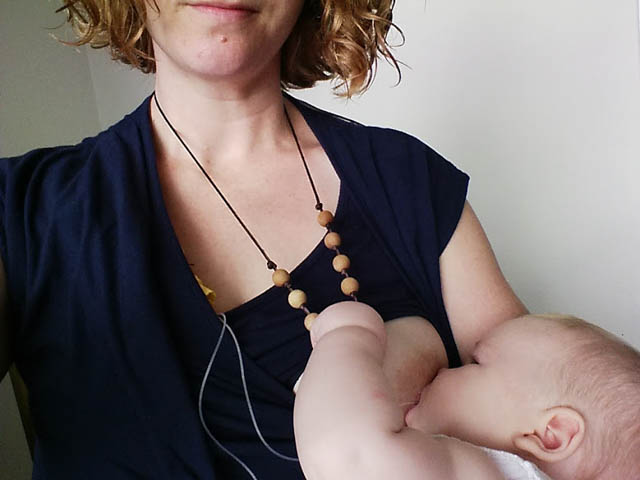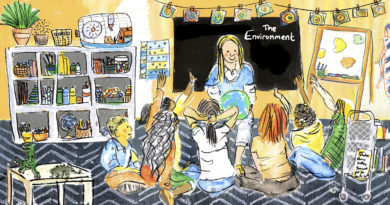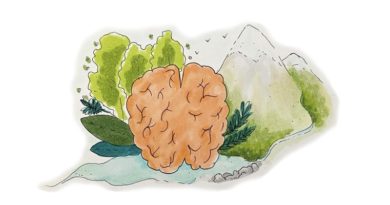Another Mother’s Milk: The All-Natural Alternative
Would you feed your baby another mother’s milk? If you watched your best friend pour her milk down the drain at the same time that you prepared formula for your baby, would you consider it? Or maybe you have a freezer full of pumped breastmilk and have no use for it all. Would you think about giving it to another mother?
Harvey was around nine weeks old when I had my epiphany, sitting on my friend’s couch, cooing at our babies who are just five weeks apart. My baby started to get hungry, so I put him to my breast and he latched on. But it was never that simple for me: at the same time, I pulled out my Supplemental Nursing System, a complex system that allows you to supplement your baby’s feed through a small tube attached to your breast. One-handedly, I squirted on a bit of hand sanitiser, balanced the bottle between my knees, opened the thermos and poured in the appropriate amount of water, tipped in the premeasured scoops of formula, closed the bottle and the valves, shook it, tucked the bottle under my bra-strap, tore off some medical tape, taped one of the tubes to my breast that wasn’t currently in use, and wiped off any formula that dripped out as one of the valves inevitably opened. I then took a deep breath to refocus on my breastfeeding baby. At nine weeks of age, this was our version of normal, and my baby continued to receive every single feed at my breast, which was my priority.
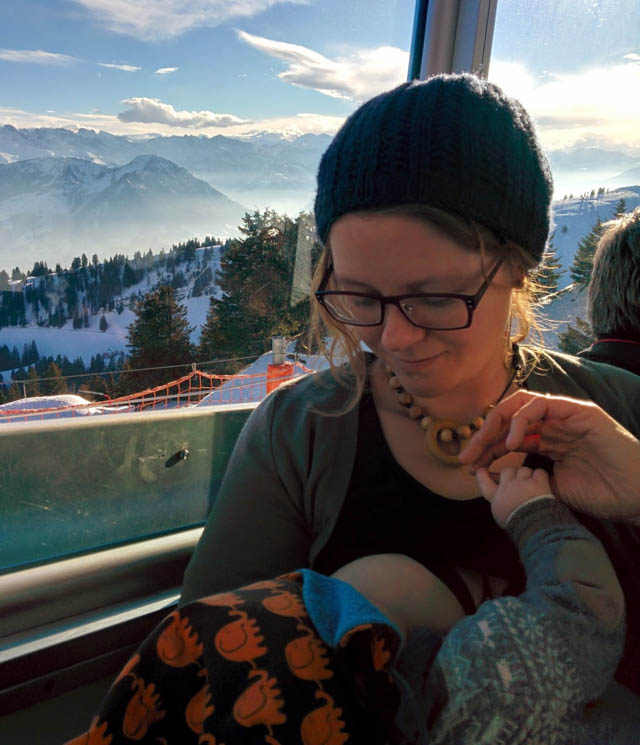
While I was latching and measuring and pouring and taping, my friend was making me a cup of tea. She bent over to pick something up off the floor. When she stood up, her shirt was all wet: the milk in the collection cups inside her bra had tipped out. “Argh, it is so annoying,” she proclaimed as my baby started whimpering and pulling at my nipple. I took a few more deep breaths and kept him there until his frustration took over. I then latched him onto the other side, ensuring the small tube sat perfectly in the corner of his mouth, the valve still closed.
I looked at the formula that was sitting in that bottle against my shoulder, and then I looked at my friend’s shirt. She was in the process of telling me that she wasn’t planning on going back to work for a year and didn’t ever foresee her baby needing a bottle, so she was just pouring her excess milk down the drain. Harvey started whimpering and pulling again, so I opened the valve. I watched the formula travelling down those little tubes and into my baby’s mouth, and I suddenly realised that I wanted her milk. I wanted to squeeze out her shirt and get those three tiny drops and put them in them into my baby’s mouth.
I didn’t say anything, though, and went home to do some research – I needed to know the facts.
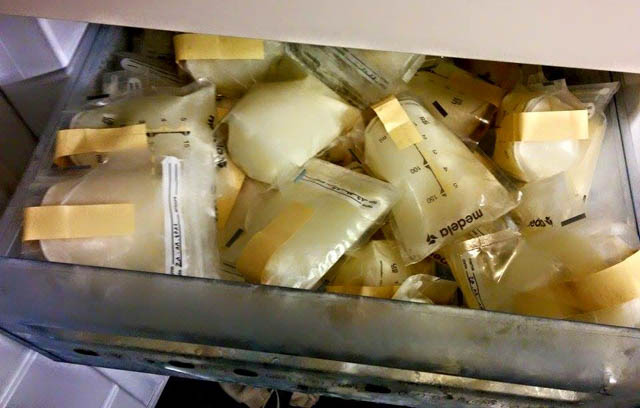
I already knew about the many benefits of breastmilk for babies. It is a living substance, balanced with everything a baby needs for the first six months of life. New research from the University of Zurich explores how it is filled with a variety of live cells and bioactive proteins that help promote an infant’s health, such as antimicrobials that protect against various harmful bacteria and viruses, and cells that function as a prebiotic, allowing the baby’s gut to grow healthy gut-flora. In a nutshell, it helps protect babies from illness (www.womenshealth.gov). I found that many official health and governmental organisations support donor milk, including the FDA and the NHS. The World Health Organisation states that the next best option after a mother’s own milk is “breast milk from a healthy wet-nurse or a human-milk bank” (www.who.int). Okay, that’s a good start!
I also learned that premature and very sick babies are able to access donor milk from the milk banks here in Switzerland. The donors are screened, their milk tested, pasteurised and made available to the most vulnerable of babies. But my baby was neither premature nor sick, so what were my options? What were the risks of me feeding my baby another woman’s breastmilk, when it did not come from a milk bank? What diseases could be transmitted? What kinds of precautions could I take to reduce those risks? Could I emulate the milk-bank procedure at home somehow? I could ask for access to up-to-date medical records, I could take the milk to be laboratory tested myself, and I could even pasteurise it myself at home. There is a wealth of information available regarding all of these issues, and only the mother herself will be able to decide how she feels about all of these considerations. A brief summary of some of these issues can be found at this webpage.
When I was totally inundated with information and felt satisfied that I knew enough, I came to the very simple realisation that my beautiful friend loved her baby so furiously, just as much as I loved mine, and that she was doing everything in her power to give him the best milk she possibly could. I knew without a doubt that I trusted my friend, this beautiful new mother, so much more than a global formula company. I started to get excited about the fact that my little baby boy would be getting a double dose of antibodies, and that the ones in her milk would be different to mine – he would develop such an incredibly immunity! How lucky he would be!
And so the seed of milk-sharing was planted. I asked my friend, and we spoke about it at length over many days, both researching, sharing evidence and anecdotal stories, and sharing our fears. Eventually, perhaps surprisingly, we decided against it: The emotional risks were too high. She was worried that she would feel guilty if she decided she would like to start storing milk for herself, or if her production levelled out and she was unable to provide for us. I ensured that she knew it was okay to just say no, and that she shouldn’t feel bad for not wanting to, for whatever reason. I must admit, though, that I definitely shed a tear in the quiet stillness of the early hours the following morning, as I once again filled those canisters with formula.
It wasn’t long, however, before my midwife put me in contact with a mother whose baby was only days older than mine, and who had an overflowing freezer of milk. The same conversations were had and she offered me access to her prenatal and postnatal medical records, which eased all of my fears. We talked at length, we met, we fed our babies, I got to know her. And then I took her milk. From that point on, my little boy was consuming only breastmilk – both hers and mine. She was worried that her milk would always taste of chilli and curry, and that my boy wouldn’t like it, but he gobbled it up and continues to love spicy things!
It was around this time that I started the Facebook support group Breastfeeding Mamas in Switzerland, now with over 550 members, as a way to surround myself with supportive, experienced, knowledgeable women as I continued on our convoluted breastfeeding journey. There, I came to know of so many mothers who had freezers full of milk “just in case,” and then found that they had no use for it. They were being advised to use it in the bath, to put a little in some puree for their babies, to freeze some as breastmilk-pops for teething. But still, litres were being wasted. Elsewhere, there were women like me, desperate to provide their babies with breastmilk, unable to access milk from the milk banks because their babies were neither premature, very ill or allergic to formula. I wanted to find a way for these women to connect, so I contacted Human Milk 4 Human Babies, a global milk-sharing network, and got a Swiss site up and running.
Human Milk 4 Human Babies Switzerland stands by the global principals of “informed, informal milk-sharing” and simply enables mothers to find each other and to connect. The rest is up to them: blood work and medical records or not, lab-testing the milk or not, home pasteurisation or not, the detailed questions they would ask about diet and lifestyle – it is all up to those mothers.
Milk sharing may not be for everyone, and I can completely understand the rational and emotional barriers that many people have when it comes to feeding a baby another mother’s milk. I feel that it is vital, however, that mothers know that this is an option available to them. New mothers deserve to be empowered with information and options, to be given real choices when it comes to how they feed their babies, and to feel confident in the path that they choose.
Article and photos by Johanna Sargeant
Johanna is an Australian living in on the shores of Lake Zurich with her husband and two young boys. She is a passionate about empowering new mothers with knowledge and confidence when it comes to feeding their babies and is studying to become a lactation consultant. Follow her on website Milk and Motherhood and on Facebook

